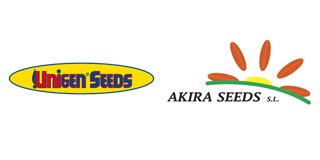
UNIGEN SEEDS SPAIN
Efficiency MAP in postharvest control of decay and quality loss of organic table grapes
The increase demand for fresh organic table grapes with perfect appearance and good sensory attributes is very challenging due to the restriction of sulphur dioxide (SO2) use on certified organic produce. In this context and in order to reach overseas promising markets, the aim of this experimental trial was to maintain the quality of organic
05 July, 2021
The increase demand for fresh organic table grapes with perfect appearance and good sensory attributes is very challenging due to the restriction of sulphur dioxide (SO2) use on certified organic produce. In this context and in order to reach overseas promising markets, the aim of this experimental trial was to maintain the quality of organic table grapes for medium and long term by using safe methods as alternatives to SO2 application. Clusters of the organic late-season variety Scarlotta seedless? were pretreated with:- different concentrations of ozone (O3) varying from 5 to 20 ppm and - carbon dioxide (CO2) at 50 and 70%, and - compared to untreated control. All the processed samples were packed in thermo-sealed?ALPAK commercial bags with 2% O2, 5% CO2, 93% N2 modified atmosphere packaging (MAP) and stored at 0?C for 45 days. The main fruit quality parameters: weight loss, grey mold incidence, berry firmness and color, total soluble solids content (TSS), pH, titratable acidity, total polyphenol and anthocyanin content, microbial analysis and sensory qualities, were measured on cluster samples immediately at harvest and after 15, 30 and 45 days under simulated shipping conditions. After 45 days, there were no signi?cant differences of physical and chemical quality parameters between pretreated samples and control. Nevertheless, the sample pretreated with O3 at 20 ppm minimized water loss compared to the samples pretreated with massive CO2 concentration. The hue angle values were inversely correlated with Color Index for Red Grapes (CIRG), particularly higher in the control and lower in the sample treated with O3 at 20 ppm. The results indicated that pretreatments did not have any significant impact on grapes quality, and highlighted the efficiency of both film packaging and MAP in postharvest control of decay and quality loss of organic table grapes stored for more than 45 days. SourcesEffect of postharvest pretreatments and MAP on organic late-season table grapes Scarlotta seedless? ?Sugranineteen? assigned to medium and long term storageN. Admane1,2, V. Verrastro2, G. Altieri1, F. Genovese1, L. Tarricone3, A. Ippolito4, G. C. Di Renzo11University of Basilicata, Italy2Centre International de Hautes Etudes Agronomiques M?diterran?ennes, Bari, Italy3Consiglio per la Ricerca e la Sperimentazione in Agricoltura, Barletta, Italy4University of Bari, ItalyV Postharvest Unlimited, ISHS International Conference, 10-13 June 2014, Cyprus, http://web.cut.ac.cy/postharvest/Picture by Sun World








